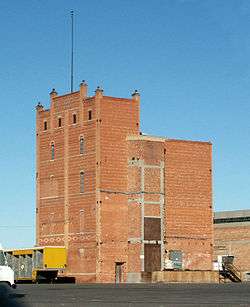Southwestern Brewery and Ice Company
The Southwestern Brewery and Ice Company is a historic brewery in Albuquerque, New Mexico, located adjacent to the BNSF railroad tracks in East Downtown. Built in 1899, it is one of the only surviving 19th-century commercial buildings in the downtown area.[3]
Southwestern Brewery and Ice Company | |
 Southwestern Brewery, south and east elevations | |
| Location | 601 Commercial St. NE Albuquerque, New Mexico |
|---|---|
| Built | 1899 |
| NRHP reference No. | 78001807[1] |
| NMSRCP No. | 397 |
| Significant dates | |
| Added to NRHP | March 30, 1978 |
| Designated NMSRCP | July 25, 1975[2] |
History
The Southwestern Brewery was founded in 1888 by Don and Harry Rankin, and later taken over by Jacob and Henry Loebs. By the start of the 20th century it was one of Albuquerque's largest employers and its flagship product, Glorieta Beer, was distributed throughout the southwest.[4] The statewide enactment of Prohibition in 1917 forced the company out of the brewing business, but its ice-making operations remained profitable. The facility changed hands several times starting in 1948, but continued to produce ice for most of the 20th century. It finally closed in 1997.[5]
The brewery was added to the New Mexico State Register of Cultural Properties in 1975[6] and the National Register of Historic Places in 1978.[1] In 1998, the former cold storage and mechanical building on the south side of the complex was destroyed by a fire that also slightly damaged the main brewery building.[7]
References
- "National Register Information System". National Register of Historic Places. National Park Service. March 13, 2009.
- "New Mexico State and National Registers". New Mexico Historic Preservation Commission. Retrieved 2013-03-13.
- Soussan, Tania (November 26, 1999). "History Written in Stone". Albuquerque Journal. NM. p. C1.
- Bannerman, Ty (2008). Forgotten Albuquerque. Charleston, SC: Arcadia Publishing. p. 99.
- Metcalf, Richard (May 18, 2009). "Historic brewery for sale - East Downtown building was home of Glorieta Beer". Albuquerque Journal. NM.
- "Properties by County" (PDF). New Mexico Department of Cultural Affairs. Retrieved 29 April 2011.
- Chunn, Sherri (March 5, 1998). "Historic Brewery Won't Be Demolished". Albuquerque Journal. NM. p. D1.
| Wikimedia Commons has media related to Southwestern Brewery and Ice Company. |